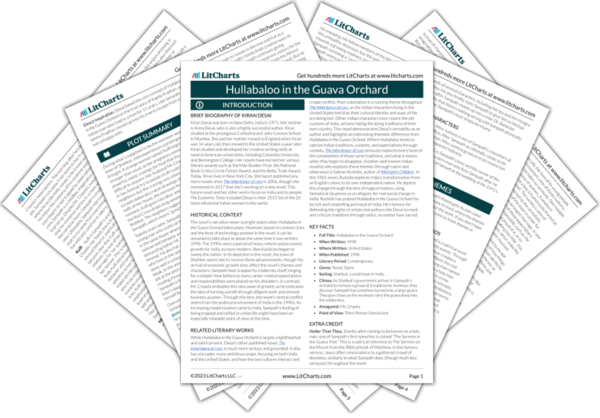Welcome to the LitCharts study guide on Kiran Desai's Hullabaloo in the Guava Orchard. Created by the original team behind SparkNotes, LitCharts are the world's best literature guides.
Hullabaloo in the Guava Orchard: Introduction
Hullabaloo in the Guava Orchard: Plot Summary
Hullabaloo in the Guava Orchard: Detailed Summary & Analysis
Hullabaloo in the Guava Orchard: Themes
Hullabaloo in the Guava Orchard: Quotes
Hullabaloo in the Guava Orchard: Characters
Hullabaloo in the Guava Orchard: Symbols
Hullabaloo in the Guava Orchard: Theme Wheel
Brief Biography of Kiran Desai

Historical Context of Hullabaloo in the Guava Orchard
Other Books Related to Hullabaloo in the Guava Orchard
Key Facts about Hullabaloo in the Guava Orchard
- Full Title: Hullabaloo in the Guava Orchard
- When Written: 1998
- Where Written: United States
- When Published: 1998
- Literary Period: Contemporary
- Genre: Novel, Satire
- Setting: Shahkot, a small town in India
- Climax: As Shahkot’s government arrives in Sampath’s orchard to remove a group of troublesome monkeys, they discover Sampath has somehow turned into a large guava. They give chase as the monkeys carry the guava deep into the wilderness.
- Antagonist: Mr. Chawla
- Point of View: Third-Person Omniscient
Extra Credit for Hullabaloo in the Guava Orchard
Holier Than Thou. Shortly after coming to be known as a holy man, one of Sampath’s first speeches is coined “The Sermon in the Guava Tree.” This is a satirical reference to The Sermon on the Mount from the Biblical book of Matthew. In this famous sermon, Jesus offers moral advice to a gathered crowd of devotees, similarly to what Sampath does (though much less seriously) throughout the novel.
Direct Inspiration. Desai based the core concept of Hullabaloo in the Guava Orchard on the true story of Kapila Pradhan, an Indian man who lived in a tree for 15 years. Like Sampath, it seems Pradhan moved up into his tree to escape from a life he was unhappy with.







